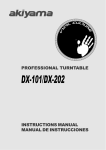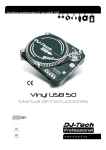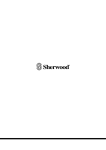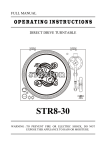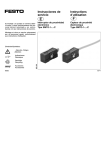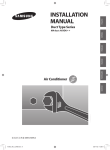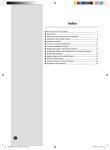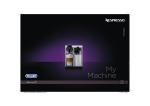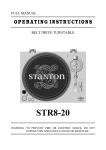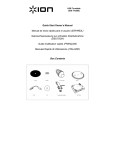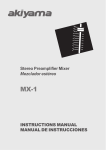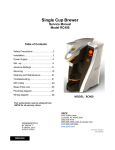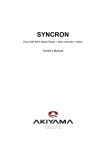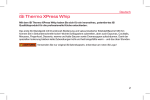Download Manual DX-303 Web
Transcript
PROFESSIONAL TURNTABLE DX-303 INSTRUCTIONS MANUAL MANUAL DE INSTRUCCIONES WARNINGS dx turntables CAUTION RISK OF ELECTRIC SHOCK DO NOT OPEN CAUTION: To reduce the risk of electric shock, do not remove any cover. No user-serviceable parts inside. Refer servicing to qualified service personnel only. The exclamation point within the equilateral triangle is intended to alert the user to the presence of important operation and maintenance (servicing) instructions in the literature accompanying this appliance. english The lightning flash with arrowhead symbol within the equilateral triangle is intended to alert the use to the presence of un-insulated “dangerous voltage” within the product's enclosure that may be of sufficient magnitude to constitute a risk of electric shock. To prevent electric shock, do not use this polarized plug with an extension cord, receptacle or other outlet unless the blades can be fully inserted to prevent blade exposure. 1. Read Instructions. All the safety and operating instructions should be read before this product is operated. 2. Retain Instructions. The safety and operating instructions should be retained for future reference. 3. Heed Warnings. All warnings on the appliance and in the operating instructions should be adhered to. 4. Follow Instructions. All operating and use instructions should be followed. 5. Water and Moisture. The appliance should not be used near water - for example, near a bathtub, washbowl, kitchen sink, laundry tub, in a wet basement, or near a swimming pool, and the like. 6. Carts and Stands . The appliance should be used only with a cart or stand that is recommended by the manufacturer. An appliance and cart combination should be moved with care. Quick stops, excessive force, and uneven surfaces may cause the appliance and cart combination to overturn 7. 8. 9. 10. 11. 12. 13. Wall or Ceiling Mounting. The product should be mounted to a wall or ceiling only as recommended by the manufacturer. Heat. The appliance should be situated away from heat sources such as radiators, heat registers, stoves, or other appliances (including amplifiers) that produce heat. Power Sources. This product should be operated only from the type of power source indicated on the rating label. If you are not sure of the type of power supply to your home, consult your product dealer or local power company. For products intended to operate from battery power, or other sources, refer the operating instructions. Grounding or Polarization. This product may be equipped with a polarized alternation-current line plug (a plug having one blade wider than the other). This plug will fit into the power outlet only one way. This is a safety feature. If you are unable to insert the plug fully into the outlet, try reversing the plug. If the plug should still fail to fit, contact your electrician to replace your obsolete outlet. Do not defeat the safety purpose of the polarized plug. Power-Cord Protection. Power-supply cords should be routed so that they are not likely to be walked on or pinched by items placed upon or against them, paying particular attention to the cord in correspondence of plugs, convenience receptacles, and the point where they exit from the appliance. Clea ning . The appl ianc e shou ld be clea ned only as recommended by the manufacturer. Clean by wiping with a cloth slightly damp with water. Avoid getting water inside the appliance. For AC line powered units. Before returning repaired unit to user, use an ohm-meter to measure from both AC plug blades to all exposed metallic parts. The resistance should be more than 100,000 ohms. 14. Non-use Periods. The power cord of the appliance should be unplugged from the outlet when left unused for a long period of time. 15. Object and Liquid Entry. Care should be taken so that objects do not fall and liquids are not spilled into the enclosure through openings. 16. Damage Requiring Service. The appliance should be serviced by qualified service personnel when: ! The power-supply cord or the plug has been damaged; or ! Objects have fallen, or liquid has been spilled into the appliance; or ! The appliance has been exposed to rain; or ! The appliance does not appear to operate normally or exhibits a marked change in performance; or ! The appliance has been dropped, or the enclosure damaged. 17. Servicing. The user should not attempt any service to the appliance beyond that described in the operating instructions. All other servicing should be referred to qualified service personnel. 18. Ventilation. Slots and openings in the cabinet are provided for ventilation and to ensure reliable operation of the product and to protect it from overheating, and these openings must not be blocked or covered. The openings should never be blocked by placing the product on a bed, sofa, rug, or other similar surface. This product should not be placed in a built-in installation such as a bookcase or rack unless proper ventilation is the manufacturer's instructions have been adhered to. 19. Attachments. do not use attachments not recommended by the product manufacturer as they may cause hazards. 20. Accessories. Do not place this product on an unstable cart, stand, tripod, bracket, or table. The product may fall, causing serious injury to a child or adult, and serious damage to the product. Use only with a cart, stand, tripod, bracket, or table recommended by the manufacturer, or sold with the product. Any mounting of the product should follow the manufacturer's ins tru cti ons , and sho uld use a mou nti ng acc ess ory recommended by the manufacturer. 20. Lightning. For added protection for this product during a lightning storm, or when it is left unattended and unused for long periods of time, unplug it from the wall outlet and disconnect the antenna or cable system. This will prevent damage to the product due to lightning and power-line surges. 22. Replacement Parts. When replacement parts are required, be sure the service technician has used replacement parts specified by the manufacturer or have the same characteristics as the original part. Unauthorized substitutions may result in fire, electric shock, or other hazards. 23. Safety Check. Upon completion of any service or repairs to this product, ask the service technician to perform safety checks to determine that the product is in proper operating condition. dx turntables 1 SPECIFICATIONS english TURNTABLE SECTION: Type Motor Driving Method Turntable Platter Speeds Wow and Flutter S/N Ratio Pitch Controls Starting Time Starting Torque Braking system Braking Time Time for Speed Change 3-speed full manual 8 pole, 3phase,brushless DC motor Direct Drive 330mm dia. Aluminum diecast 331/3 and 45 rpm and 78 Rpm Less 0.15% WRMS with 33 1/3rpm More than 60dB (DIN-B) +/- 8%,12%,20% Less than 1 sec More than 1.6 Kgf.cm Electronic brake Less than 1 sec. Less than 1 sec. from 331/3 to 45 rpm. Less than 1 sec. from 45 to 331/3 rpm. Less than 1 sec. from 331/3 to 78 rpm TONEARM SECTION: Type Effective Arm Length Overhang Tracking Error Angle Applicable Cartridge Weight Anti-skating Range Output Frequency Response Channel Separation Channel Balance Needle Pressure range High of cue(first track) Descend of cue Static balanced S-shaped tonearm with detachable headshell 230.5mm 15mm Less than 3 degree 13~18g 0-3g 1.5~3.6mV at 1KHz 5cm/sec 20Hz-20KHz More than 15dB Within 2.5dB at 1KHz 3~4g 7.5~10mm 1~3sec GENERAL SECTION: Power Supply Power Consumption Dimensions Weight AC 230V, 50Hz 10.5 Watts 450 (W) x 370 (D) x 86 (H) mm 8.5 Kgs ACCESSORIES SUPPLIED Instruction manual x 1, Headshell x 1, 45 rpm adaptor x 1, Counter weight x 1, AC cord x 1, RCA cable x 1, Platter x1 Slipmat x 1, Target light x 1 TECHNICAL SPECIFICATIONS DESCRIPTIONS UNIT NORMAL LIMIT (1) Outp ut Difference dB 2.3 2.5 (2) Outp ut Level mv 1.7~3.5 1.5~3.6 (3) Sp eed (Sp eed Range) +/- 8% Hz 2760↓, 3240↑ 2770↓,3230↑ (3) Sp eed (Sp eed Range) +/- 12% Hz 2640↓, 3360↑ 2650↓, 3350↑ (3) Sp eed (Sp eed Range) +/- 20% Hz 2400↓, 3600↑ 2410↓, 3590↑ (4) Sp eed (Center Range) Hz 2995~3005 2990~3010 % 0.1 0.15 dB 16 15 (5) Wow and Flutter (6) Channel s eparation NOTE: CARTRIDGE(AT3600L) dx turntables 2 PART NAMES AND FUNCTIONS dx turntables 16 15 17 18 3 14 13 english 1 12 2 11 10 9 1 4 5 6 7 8 1) START/STOP Press this button to start or stop the platter. Use this to change the speed of the platter when the PITCH indicator is NOT lit. 2) PLATTER 3) MOTOR OFF Press the button to enable motor off, and the led will be flash Press the button again to disable function. 11) TONE ARM This is a fully manual tone arm. To start playback, gently place the stylus on the record using the headshell finger support. Do not drop the stylus onto the record as it may cause damage to the diamond tip and to the record. 4) TARGET LIGHT Insert target light to the deck and it will light up. 12) 45 RPM ADAPTOR Place on centre spindle for playing 7” records with large centre holes. 5) PLATTER REVOLUTION SPEED BUTTONS 33 rpm press 33 45 rpm press 45 78 rpm press 33 and 45 13) ANTI SKATE KNOB When a record is playing, a force is generated drawing the stylus towards the centre of the record. Set this knob to the same value as the stylus pressure to offset this force. 6) REVERSE This button is used to reverse the direction of the platter rotation. 14) COUNTER WEIGHT Use this to balance the tone arm and to adjust the stylus pressure. 7) +/-8%,+/-12%,+/-20% Press the button to switch to 8%, press again to switch to 12%, and again to 20%. 15) POWER SWITCH This switch turns the power on or off, including the motor and audio signal. 8) QUARTZ LOCK On will hold the revolution speed to 0%. Off will allow use of the pitch adjust. 16) POWER CORD CONNECTOR Used to connect the included power cord. 9) HEADSHELL LOCKING NUT Attach the headshell by inserting into the front end of the tone arm, then turn the locking nut clockwise with the head shell firmly held horizontally. 17) OUTPUT SIGNAL SELECTOR Two forms of output audio signal are available: Phono and Line. 18) AUDIO OUTPUT CONNECTOR This is the audio output connector (RCA). Must be connected as explained at Connections part of this manual. 10) PITCH SLIDER dx turntables 3 english TONE ARM ASSEMBLY 19.Headshell - Install cartridge here. When installing a cartridge, refer to the installation instructions supplied by the manufacturer of that cartridge. During installation, attach the stylus protector to guard the stylus tip from damage. Attach wires as follows: White (L+) Left channel+ Blue (L-) Left channel Red (R+) Right channel+ Green (R-) Right channel- 23 22 20.S-Shaped ToneArm 21 21.ToneArm Lift - This elevates the tone arm above the record surface. 24 22.Anti-Skate Control - This applies inward force to the tone arm so it doesn't skip outward across the record due to the centrifugal force of the record spinning. Cartridge manufacturers usually specify the proper setting of this. 23.Counterweight - Adjustment creates the proper downward pressure of the stylus to the record. Attach now by sliding the counterweight onto the rear of the tone arm. Twist it lightly and it will screw onto the rear shaft of the tone arm. 20 19 24.Tone Arm Clamp and Rest - Use this rest for the tone arm and clamp it in position during transportation. OPERATION 1. Push the power to on and the speed indicator and the strobeilluminator will light up. 10. Set the desired pitch adjusts range by depressing the buttons until the desired pitch is reached. Options are +/-8% or +/-12% or +/-20%. 2. Insert target light for illumination the stylus. 3. Place a record on the turntable mat. When playing a 45rpm record with a large center hole; place the 45-rpm adapter on the centre spindle. 4. Set the rotation speed (33/45/78) to match the record. 11. Adjust the pitch to a desirable speed. During play, observe the strobe dots. If the strobe dots appear to the right, the pitch is slower than the rated speed. If they flow to the left, the rated speed. If the strobe dots appear stationary, which means the platter is in normal turntable speed, move the pitch control slider up or down to adjust the speed. 5. Release the arm clamp. 12. To suspend play, lift tone arm with cueing lever. 6. Set the cueing lever to the up position. 7. Press the Start/Stop button and the turntable platter will start to rotate. 13. When play is finished, raise the cueing lever, move the tone arm to the armrest and secure the tone arm with the arm clamp. 14. Press the Start/Stop button to stop the platter rotating. 8. Move the tone arm over the desired groove. 15. Push the power to off. 9. Set the cueing lever to the down position, the tone arm will descend slowly onto the record and play begins. dx turntables 4 AVISOS SEGURIDAD dx turntables ATENCIÓN: PARA REDUCIR EL RIESGO DE ELECTROCUCIÓN, NO MANIPULE EL INTERIOR DEL EQUIPO. PARA REALIZAR EL MANTENIMIENTO DEL EQUIPO PONGASE EN CONTACTO CON EL PERSONAL CUALIFICADO CAUTION RISK OF ELECTRIC SHOCK DO NOT OPEN Esta señal indica la presencia de lugares donde habiendo un elevado voltaje no presentan aislamiento y por tanto constituye un claro riesgo de electrocución. Esta señal indica la presencia de componentes del equipo que precisan de mantenimiento. Para más información sobre éstos lea el manual. Para prevenir un posible riesgo de electrocución asegúrese de que al conectar el equipo a la red el conector encaja perfectamente en la toma de la pared o del adaptador. Las puntas del conector no deben quedar expuestas. 1. Lea detenidamente este manual antes de utilizar su equipo. 2. Mantenga el manual a su disposición para su uso en el futuro. 3. Siga las advertencias que se le proporcionan en este manual. 4. Siga las instrucciones consignadas en este manual, un uso indebido podría dejar sin efecto la garantía. 5. Agua y humedad. No utilice el equipo cerca del agua o en lugares muy húmedos (fregadero, lavadora, etc.) para evitar riesgos de descarga eléctrica o fuego. 6. Transporte del equipo. Transporte el equipo con mucho cuidado. Los golpes o las vibraciones fuertes pueden dañarlo mecánicamente. 7. Montaje en pared o techo. Siga las instrucciones del fabricante. 8. Fuentes de calor. Tenga cuidado de no colocar el equipo cerca de fuentes de calor (Ej. radiadores, estufas, amplificadores) 9. Voltaje. Antes de conectar el aparato a la red asegúrese de que se trata del mismo voltaje y frecuencia para las que el equipo está especificado. En caso contrario no conecte el equipo y póngase en contacto con su distribuidor. 10. Protección del cable. Escoja una posición para el cable de corriente de modo que esté lo menos expuesto a pisotones y demás agresiones. Especial atención con los dos extremos del cable de toma de corriente, la clavija de enchufe a la red y la clavija de alimentación del equipo. 11. Limpieza. Desconecte el equipo antes de realizar alguna operación de limpieza del aparato. Utilice un trapo suave y seco para limpiar. Asegúrese de que los cables están correctamente conectados antes de volver a enchufar el aparato. 12. Control de seguridad. La diferencia de potencial entre la toma de corriente de la pared y cualquier pieza metálica del equipo debe ser de al menos 100.000 ohmios. 13. Periodos largos de reposo del equipo. Desconecte el equipo de la red en caso de reposo prolongado. 14. Líquidos y objetos extraños. En caso de que algún fluido o pequeñas partículas sólidas sean derramadas sobre el aparato y se introduzcan en los circuitos apague el aparato y llévelo a su distribuidor. 15. Daños en el quipo que precisen reparación. El equipo deberá ser reparado o revisado por personal cualificado en caso de: A. El cable de toma de corriente o su conector han sido dañados. B. Objetos o líquidos se han introducido en el equipo. C. El aparato ha sido expuesto a la lluvia. D. El equipo no parece funcionar o lo hace de modo poco usual. E. EL aparato ha caído al suelo o presenta deterioros en su caja exterior. 16. Mantenimiento. No abra el equipo para labores de mantenimiento pues en este aparato no hay piezas que necesiten manutención. En caso de que abriendo el equipo sea éste dañado o lo sea la persona que lo manipula la empresa no será responsable por este servicio de mantenimiento no autorizado. Además en este caso la garantía perdería su vigencia. 17. Ventilación. El aparato está provisto de hendiduras de ventilación, es importante no cubrirlas o bloquearlas. La ventilación del aparato podría verse comprometida resultando en un sobrecalentamiento que podría dañar el equipo. Tenga siempre en cuenta que colocar el aparato en un lugar sin ventilación puede producir un sobrecalentamiento de éste. 18. Nunca utilice accesorios o modificaciones no autorizados por el fabricante. Ello puede afectar la seguridad del aparato y el fabricante no será responsable en este caso. 19. Accesorios. No deposite o instale el equipo sobre superficies o estructuras inestables. El aparato podría precipitarse y causar lesiones a las personas en las proximidades de éste. Cualquier montaje o instalación del equipo deberá ser realizado siguiendo las instrucciones o recomendaciones dadas en este manual o por el fabricante directamente. 20. Precaución durante tormentas. Durante una tormenta desconecte el equipo de la red para evitar que los posibles picos de corriente dañen el equipo. 21. Durante cualquier manipulación del equipo, para mantener todas las cualidades de éste tanto en prestaciones como en seguridad para el oper ante es nece sari o util izar solo reca mbio s orig inal es. Consecuentemente asegúrese de que la empresa que realice el mantenimiento sea autorizada por el fabricante o importador. 22. Comprobación de seguridad. Una vez realizada una reparación o servicio del equipo pida al personal cualificado que realice una comprobación para asegurarse de que el equipo le es devuelto en perfectas condiciones de uso. dx turntables 5 ESPECIFICACIONES GIRADISCOS: Tipo Motor Sistema de giro Plato giratorio Velocidades de giro Wow and Flutter Ratio S/N Par de arranque Control de Pitch Tiempo de arranque Sistema de frenado Tiempo de freno Tiempo de cambio de velocidad Completamente manual de 3 velocidades 8 pole, 3phase,brushless DC motor Tracción Directa 330mm dia. Aluminum diecast 331/3, 45 rpm y 78 rpm Menos de 0.15% WRMS (JIS WTD) a 33 rpm Más de 60dB (DIN-B) Más de 1.6 Kgf.cm +/- 8%,12%,20% Menos de 1 seg. Freno electrónico Menos de 1 seg. Menos de 1 seg. desde 33 1/3 a 45 rpm. Menos de 1 seg. desde 45 a 331/3 rpm. Menos de 1 seg. desde 331/3 a 78 rpm. BRAZO: Brazo estático tipo S con cápsula reemplazable 230 mm 15mm Menos de 3 grados 13~18g 0-3g 1.5~3.6mV at 1KHz 5cm/seg 20Hz-20KHz Más de 15dB Entre 2.5dB a 1KHz 3~4g 7.5~10 mm 1~3seg. Tipo Longitud efectiva del brazo Overhang Tracking Error Angle Carga aplicable a capsula Rango de Anti-skating Salida Respuesta en frecuencia Separación de canales Balance de canal Rango de presión de aguja Altura de Cue (primera pista) Descenso de Cue GENERAL: Alimentación Consumo Dimensiones Peso AC 230V, 50Hz 10.5 Watts 450 (W) x 370 (D) x 86 (H) mm 8.5 Kgs ACCESSORIOS SUMINISTRADOS Manual de instrucciones x 1, Cápsula x 1, adaptador a 45 rpm x 1, Contrapeso x 1, Cable corriente x 1, Cable RCA x 1, Plato x1 Slipmat x 1, Target light x 1 ESPECIFICACIONES TÉCNICAS DESCRIPCIONES UNIDADES NORMAL LIMITE (1) D iferencia en s alida dB 2.3 2.5 (2) N ivel de s alida mv 1.7~3.5 1.5~3.6 (3) Velocidad (rango) +/- 8% Hz 2760↓, 3240↑ 2770↓,3230↑ (3) Velocidad (rango) +/- 12% Hz 2640↓, 3360↑ 2650↓, 3350↑ (3) Velocidad (rango) +/- 20% Hz 2400↓, 3600↑ 2410↓, 3590↑ (4) Sp eed (Center R ange) Hz 2995~3005 2990~3010 % 0.1 0.15 dB 16 15 (5) Wow and Flutter (6) Sep aración ent re canales NOTA: CAPSULA(AT3600L) MANTENIMIENTO Limpie la aguja periódicamente con un cepillo suave para evitar la acumulación de polvo. En caso de que el sonido pierda calidad, verifique que la aguja está en perfectas condiciones. En caso contrario reemplácela. Periódicamente, la tapa y la carcasa del equipo deben ser limpiadas con un trapo suave y seco. No use cerca del equipo sustancias volátiles como el alcohol, gasolina, etc. éstos podrían dañar el acabado superficial de éste. dx turntables 6 dx turntables DESCRIPCION DE MANDOS Y FUNCIONES 16 15 17 18 3 1 14 13 12 2 11 10 9 1 4 1. PUESTAEN MARCHA YPARO Presione este botón para poner en marcha o parar el plato. 2. PLATO 3. PARADA DEL MOTOR Presione este botón para parar el plato, el Led parpadeará. Presione otra vez para anular el paro. 4. LUZ PARAILUMINACIÓN DE LA AGUJA Inserte la luz en su conexión y se encenderá, apunte a la aguja. 5. SELECCIÓN DE VELOCIDAD DE GIRO (rpm) 33 rpm Presione 33 45 rpm Presione 45 78 rpm Presione los botones 33 y 45 simultáneamente. Para volver al modo de velocidad 33 ó 45 rpm simplemente presione el botón adecuado. 6 7 8 11 . BRAZO Es completamente manual. Para iniciar la reproducción de un disco sitúe la aguja en la superficie del disco utilizando el brazo del porta cápsulas. No suelte bruscamente el brazo, podría dañar el disco y la aguja. 12. ADAPTADORA 45 R.P.M. Sitúelo alojado en el centro del eje para reproducir aquellos discos que lo precisen. 13. CONTROL ANTI-PATINAMIENTO (ANTI-SKATE) Al reproducir un disco una fuerza es generada atrayendo la cápsula hacia el centro de rotación del disco. Para contrarrestar esta fuerza actúe sobre el control anti-patinamiento. Los fabricantes de cápsulas acostumbran a proporcionar el valor de Anti-Skate adecuado para cada modelo. 14. CONTRAPESO Su ajuste proporciona la fuerza descendente adecuada para el trabajo de la aguja sobre el disco. 6. CONTROL DE SENTIDO DE GIRO Utilícelo para escoger el sentido de giro. 7. RANGO DE PITCH +/-8%,+/-12%,+/-20% Presione el botón repetidamente para seleccionar los distintos rangos de Pitch disponibles. 8. QUARTZ LOCK Activada: mantiene la velocidad de giro a un 0% de PITCH. 9. ROSCA DE BLOQUEO DEL PORTACÁPSULAS Inserte el porta cápsulas en el extremo del brazo. Gire la rosca en el sentido de las agujas de reloj manteniendo el porta cápsulas firme en posición horizontal 10. AJUSTE DE VELOCIDAD “PITCH” Utilícelo para variar la velocidad de giro del plato. 5 15. PUESTAEN MARCHA DEL EQUIPO Arranque y paro de motor y audio 16. CONECTOR PARACABLE DE RED Conecte aquí el cable de red. 17. SELECTOR DE SEÑAL DE SALIDA Podemos escoger entre dos formatos de señal de salida; Phono y Línea. 18. CONEXIÓN DE SALIDA PHONO/LINE Es la salida (RCA) de la señal de audio. Deberá ser conectada tal como se indica en el apartado Conexiones. dx turntables 7 19. PORTACÁPSULAS Instale la cápsula aquí. Al instalarla siga las instrucciones proporcionadas por el fabricante de la misma. Durante la instalación disponga el protector de la aguja para evitar desperfectos. CONJUNTO BRAZO Conecte los cables al terminal de la cápsula. La mayoría de los cables están codificados por colores. Conecte cada cable al terminal del mismo color: 23 Blanco (L+), … canal izquierdo + Azul (L-), … canal izquierdo Rojo (R+), … canal derecho + Verde (R-), …. canal derecho 22 21 24 20 20.BRAZO METÁLICO TIPO “S” 21. ELEVADOR DEL BRAZO Permite elevar el brazo por encima de la superficie del disco 22. CONTROL ANTI-PATINAMIENTO (ANTI-SKATE) Al reproducir un disco una fuerza es generada atrayendo la cápsula hacia el centro de rotación del disco. Para contrarrestar esta fuerza actúe sobre el control anti-patinamiento. Los fabricantes de cápsulas acostumbran a proporcionar el valor de Anti-Skate adecuado para cada modelo. 23. CONTRAPESO Su ajuste proporciona la fuerza descendente adecuada para el trabajo de la aguja sobre el disco. Montaje del contrapeso: encaje el contrapeso en el extremo posterior del brazo, gírelo y enrósquelo. Ajuste del punto cero (0) del balance horizontal y de la presión de la aguja: 19 A. Retire el protector de la aguja sin tocar ésta. B. Disponga la palanca (21) tal que el brazo esté en su posición más baja. C. Retire el seguro que inmoviliza el brazo y déjelo en posición de libre movimiento. D. Manipule el contrapeso hasta que el brazo esté nivelado horizontalmente (flotará un poco). E. Vuelva a inmovilizar el brazo con el seguro. Manteniendo el contrapeso inmóvil, gire la escala de éste hasta que el punto cero esté alineado con la marca coaxial del brazo. F. Gire el contrapeso en el sentido de las agujas del reloj hasta que la escala muestre el valor de presión correspondiente a la aguja utilizada. En el caso de la aguja que se proporciona con el equipo el valor es 2gr. 24.FIJACIÓN DEL BRAZO Permite fijar el brazo. Utilícelo al transportar el giradiscos. IMPORTANTE. Retire el contrapeso del brazo siempre que transporte el tocadiscos. En caso contrario puede romperse el brazo. En este caso perdería la garantía. FUNCIONAMIENTO 1. Accione el botón de puesta en marcha. El indicador de velocidad y la luz del estroboscopio se encenderán. 9. Disponga la palanca elevación/descenso tal que el brazo descienda hasta posar la aguja sobre la pista del disco deseada. En este momento comenzará la reproducción. 2. Inserte la luz de punto de aguja. 3. Ponga un disco en la alfombrilla, en caso de ser un disco a 45 r.p.m. Deberá situar el adaptador encajándolo en el tetón central. 10. Seleccione el rango de velocidad (PITCH) deseado, a +/-8% ó +/-12% ó +/-20%. 11. Ajuste el control de velocidad PITCH a la velocidad deseada. 4. Escoja el valor de velocidad de giro adecuado al disco que va a reproducir (33/45/78) . 5. Retire el protector de la aguja y libere el brazo. 12. Cuando quiera terminar la reproducción sitúe el brazo en posición levantado. 6. Disponga la palanca elevación/descenso tal que el brazo esté levantado. 13. Cuando la reproducción ha terminado, levante el brazo mediante la palanca elevación/descenso y fíjelo en su posición de reposo. 7. Presione el botón “Start/Stop”, el plato comenzará girar. 14. Accione el botón “Start/Stop” para que el plato deje de girar. 8. Sitúe el brazo encima de la pista que desea comenzar a reproducir. 15. Presione el botón de encendido para desconectar el aparato. dx turntables 8 CONNECTIONS/CONEXIONES dx turntables english DX-303/DX-505 turntables offer two signal output possibilities, PHONO and LINE. The output mode will be selected by means of the selector switch located at the rear side of the turntable. If PHONO is selected the unit must be connected to a device equipped with Phono input RIAA. Most likely this will be a stereo mixer as seen at the draw below. Al escoger PHONO deberemos conectar el giradiscos a un equipo dotado de entrada Phono (RIAA). Normalmente este equipo será un mezclador estéreo como se muestra en el dibujo. If LINE is selected the unit can be connected to almost all amplifying units. Just make sure that you connect it at the Line level input of the amplifier. This will be labelled as Line, CD, Tape or AUX. english Los giradiscos DX-303 y DX-505 disponen de dos posibles formatos de señal de salida, PHONO y LÍNEA. Mediante el selector situado en el panel trasero podremos seleccionar el formato de señal de salida adecuado. Al escoger el formato LÍNEA podremos conectar el giradiscos a cualquier amplificador o mezclador. En caso de desear conectar el giradiscos a un amplificador doméstico deberemos seleccionar una entrada tipo Línea. Normalmente estas entradas aparecen señaladas como Línea, CD, Tape o AUX. En el dibujo se muestran los distintos tipos de conexión que podemos realizar. This product complies with the EMC and LVD European Directives inputs outputs STEREO MIXER ANY OF THESE THREE INPUT IS SUITABLE CUALQUIERA DE ESTAS TRES ENTRADAS ES ADECUADA LINE/CD TAPE AUX L R VOLUME LINE/CD TUNER TAPE AUX INPUT SELECTOR DOMESTIC AMPLIFIER dx turntables 9 C/ Praga, nº11. P. Cova Solera. 08191 Rubí (España). Tel: 0034935861730. Fax: 0034936996087 [email protected] / www.akiyamadj.com











